HUNTING FOR THE TRUTH OF CAPTAIN KIDD IN OLE MONMOUTH COUNTY
By Michael J. Launay for Weird NJ
It was cold and rainy on the morning of May 23, 1701 in London, England; perfect weather for an execution. The convicted, William Kidd, was lead to the gallows, defiant to the end. The noose was placed around his neck and the wood block kicked out from beneath him. Although the rope broke and Kidd’s life was spared for a few moments, a second attempt put an end to the brief career of the one of the most famous pirates in history. The end of Kidd’s life was only the beginning of his legend though, for what most people remember him for is not his adventures, but his infamous buried treasure––which many believe is may still be waiting to be discovered right here in New Jersey.
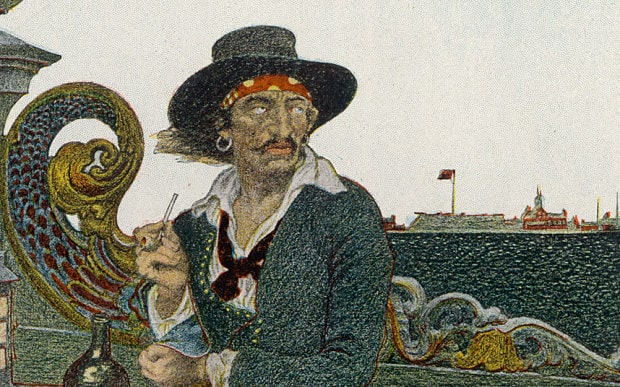 Many people today are unaware of the role New Jersey, and especially the Raritan Bay shore, played in the lives of many pirate legends in the late l7th and early I8th centuries. The waters between Sandy Hook and New York City were infestedwith pirates and French privateers. Blackbeard raided farms and villages near what is today Middletown, and Captain Morgan often visited the area. A triad of politicians, businessmen, and ship owners who were either bribed by, or did business with the pirates, protected them. Many wealthy colonial families’ fortunes began by either investing in pirate expeditions, or buying plundered goods and reselling them at a large profit. Pirates were not only tolerated, but in many cases they were openly encouraged. The most famous pirate to ever trawl the Jersey waters was the notorious Captain Kidd.
Many people today are unaware of the role New Jersey, and especially the Raritan Bay shore, played in the lives of many pirate legends in the late l7th and early I8th centuries. The waters between Sandy Hook and New York City were infestedwith pirates and French privateers. Blackbeard raided farms and villages near what is today Middletown, and Captain Morgan often visited the area. A triad of politicians, businessmen, and ship owners who were either bribed by, or did business with the pirates, protected them. Many wealthy colonial families’ fortunes began by either investing in pirate expeditions, or buying plundered goods and reselling them at a large profit. Pirates were not only tolerated, but in many cases they were openly encouraged. The most famous pirate to ever trawl the Jersey waters was the notorious Captain Kidd.
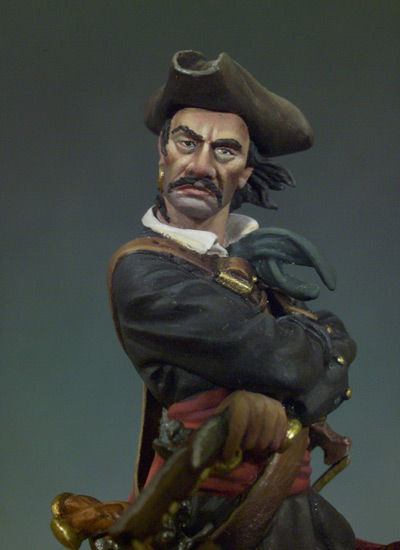 Captain Kidd was a resident of New York City when he traveled to England in 1695 in search of a commission in the Royal Navy. He was born around 1645 in Scotland, and after commanding a privateer ship (a government sanctioned form of piracy against ships of enemy countries) in a successful expedition in the Caribbean, he established himself as a wealthy and politically connected colonist. Kidd then married a wealthy Monmouth County widow. Failing to gain a command in the British Navy, he was persuaded by political associates and schemers to seek a privateering license. With backing from many of the leading men of the time in England, Kidd was granted a license by the King to seize and capture French and pirate ships, and split the booty with the crown and his backers.
Captain Kidd was a resident of New York City when he traveled to England in 1695 in search of a commission in the Royal Navy. He was born around 1645 in Scotland, and after commanding a privateer ship (a government sanctioned form of piracy against ships of enemy countries) in a successful expedition in the Caribbean, he established himself as a wealthy and politically connected colonist. Kidd then married a wealthy Monmouth County widow. Failing to gain a command in the British Navy, he was persuaded by political associates and schemers to seek a privateering license. With backing from many of the leading men of the time in England, Kidd was granted a license by the King to seize and capture French and pirate ships, and split the booty with the crown and his backers.
In May, 1696, Kidd set sail from England to New York City in his new ship, the Adventure Galley. On the way, much of his crew was impressed (forcibly drafted) by a British Navy warship. This forced Kidd to recruit a new crew when he arrived in New York and to pay them a larger share of the profit than he expected. He promised the crew sixty percent of the booty taken, but unfortunately he had already promised sixty percent to his backers. With this inauspicious start, Kidd left for the Red Sea to seek his fortune.
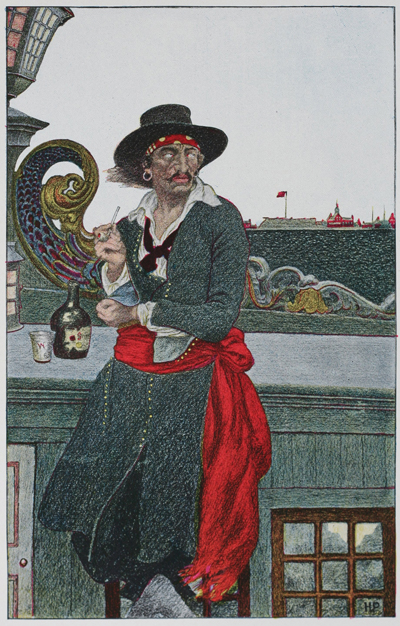 In the spring of 1697, the Adventure Galley arrived in the Red Sea. Kidd quickly forgot about his primary mission, and ignored various pirates he encountered. He even docked in the same ports with some, making no attempt to apprehend them, as he was commissioned to do by the license granted him by the King. Kidd did try to keep to his promise to attack only French ships at first. However, his crew quickly tired of allowing rich ships of other nationalities to pass unmolested, and attempted a mutiny. It was during this revolt that Kidd killed a gunner, William Moore, with a blow to the head, using a bucket as a weapon. The crew backed down, but Kidd was forever changed by the incident, and began to attack ships no matter what their nationality or origin. He had officially become a pirate.
In the spring of 1697, the Adventure Galley arrived in the Red Sea. Kidd quickly forgot about his primary mission, and ignored various pirates he encountered. He even docked in the same ports with some, making no attempt to apprehend them, as he was commissioned to do by the license granted him by the King. Kidd did try to keep to his promise to attack only French ships at first. However, his crew quickly tired of allowing rich ships of other nationalities to pass unmolested, and attempted a mutiny. It was during this revolt that Kidd killed a gunner, William Moore, with a blow to the head, using a bucket as a weapon. The crew backed down, but Kidd was forever changed by the incident, and began to attack ships no matter what their nationality or origin. He had officially become a pirate.
After attacking and capturing several ships, Kidd made his name in pirate lore with the capture of the Quedah Merchant, a fabulously rich Indian ship traveling with silks, guns, spices and gold. He split some of the booty with his crew, scuttled the Adventure Galley, and sailed for the Caribbean on the captured Indian vessel, now renamed the Adventure Prize. Upon arrival, Kidd learned he’d been denounced as a pirate, and was wanted by the British crown. After scuttling the ship, he purchased a small sloop named the San Antonio and headed for Boston with a small crew and hoped to take care of the problem.
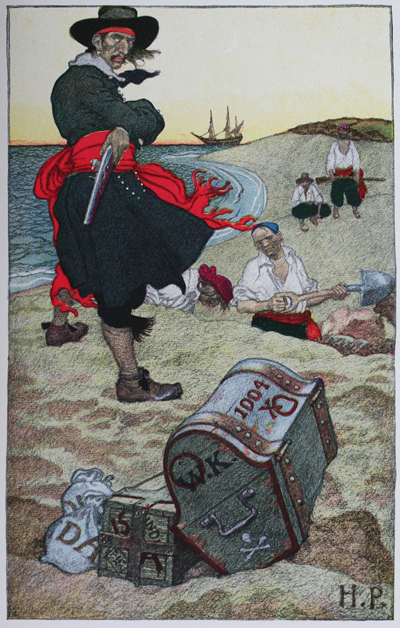 On the way to Boston, Kidd stopped at various locations in New Jersey, and dropped anchor off the coast of Monmouth County, in the Raritan Bay. From there he sent landing parties ashore to both New Jersey and New York City to fix his “pirate problem” by using his political connections and the proceeds of his captured booty. It was common practice for pirates to buy safety or pardons from corrupt colonial politicians. After bribing all the appropriate people, and hiding some of his treasure, Kidd left for Boston to meet with the governor.
On the way to Boston, Kidd stopped at various locations in New Jersey, and dropped anchor off the coast of Monmouth County, in the Raritan Bay. From there he sent landing parties ashore to both New Jersey and New York City to fix his “pirate problem” by using his political connections and the proceeds of his captured booty. It was common practice for pirates to buy safety or pardons from corrupt colonial politicians. After bribing all the appropriate people, and hiding some of his treasure, Kidd left for Boston to meet with the governor.
Upon his arrival in Boston, Kidd was arrested by the new governor, a fairly honest man for his day, and imprisoned. He claimed to have hidden a treasure of 40,000 British Pounds, but rumors at the time put his missing treasure at 400,000 Pounds. Only 10,000 Pounds was ever recovered, and it was sent to England along with Kidd in early 1700. In order to protect prominent backers and associates, Kidd was given a quick trial before the Admiralty Court, with limited evidence allowed by the 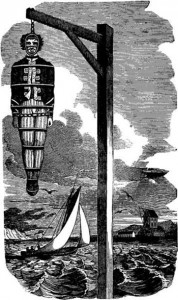 court, and some evidence suppressed by the prosecution. He was found guilty of the murder of William Moore and of piracy and was sentenced to be publicly hanged. He maintained his innocence to the end, and promised to retrieve his treasure to give it to his backers and the government if only they would release him and give him a ship. Whether he was telling the truth, or just trying to save his neck, we will never know.
court, and some evidence suppressed by the prosecution. He was found guilty of the murder of William Moore and of piracy and was sentenced to be publicly hanged. He maintained his innocence to the end, and promised to retrieve his treasure to give it to his backers and the government if only they would release him and give him a ship. Whether he was telling the truth, or just trying to save his neck, we will never know.
After his execution, Kidd’s body was covered with tar, bound with chains, and hung over the Thames River in London as a warning to all future pirates. It remained there for years until finally it rotted completely away.
The Treasure Hunt in New Jersey
Soon after Captain William Kidd’s arrest, gold and other treasure worth about 20,000 pounds (more than $1 million in today’s value) was dug up on Gardiner’s Island off the coast of Long Island, NY. Kidd left it there in the care of Jonathon Gardiner, who cooperated with British authorities in retrieving it (amazingly, Gardiner’s Island is still privately owned by the Gardiner family after 400 years). The finding of this treasure, along with Kidd’s insistence of a fabulous treasure hidden elsewhere, began the never-ending search for the legendary buried treasure of Captain Kidd.
Although many places in New Jersey have been advanced as the site of Kidd’s hidden treasure, four have a particularly strong claim. One site is Cape May, where pirate and other ships often stopped because it was a source of fresh water. Another possible location is an island that was located at the mouth of the Toms River, an area that provided protection for pirates from the ocean elements. A third area is Sandy Hook, near where Kidd anchored on his final voyage in Raritan Bay.
Probably the most famous and plausible burial site was just north of Sandy Hook near Whales (Wales) Creek, which today is the southeast border of Middlesex and Monmouth counties. Just off the shoreline was a small island where some 17th century Spanish gold coins were found. This island became known as Money Island, and was located off the coast where Cliffwood Beach is today. It has long since disappeared under the eroding waters of the Raritan Bay, aided by extensive excavation over the centuries. Just inland from this location is a small body of water once called Duck Pond, but now known as Treasure Lake, where some additional gold coins were found.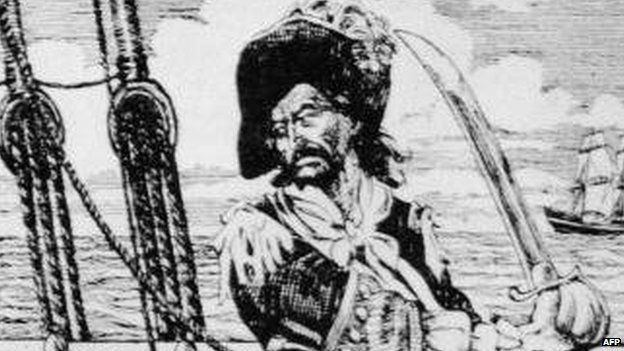
What is not a legend, and cannot be disputed, was the existence of two gigantic elm trees, which were known as Kidd’s Rangers. One was at the mouth of Matawan Creek, in Keyport, and stood until the turn of this century. The other was located at Fox Hill, now known as Rose Hill. These trees, according to legend, acted as range markers to guide Kidd back to his buried gold, and Cliffwood Beach is centered between these two markers when sailing west from Long Island.
To this day, you can still see people occasionally searching for treasure at Cliffwood Beach using shovels and medal detectors. On occasion some tiny bits of gold and silver are sill found, but whether they are ancient or modern in age has not been determined.
Other Likely Places to Dig
The Raritan Bay is by no means the only place on the Jersey shore suspected to by the hiding spot for Kidd’s long buried booty though. In the book Down Barnegat Bay (Beachcomber Press, 1980), author Robert Jahn writes:
Another legend holds that Captain Kidd romanced a Barnegat farm girl by the name of Amanda, and buried a treasure chest near Oyster Creek, NJ. A different old story claims Kidd sailed up from Barnegat Inlet and landed on an island near Toms River, long since known as Money Island… Down through the years wandering beachcombers have occasionally found Spanish doubloons and pieces-of-eight, washed up on the beach at low tide…These rumors also say that Captain Kidd landed during his last voyage, and hid several chests filled with silver and gold near a pond behind a range of dunes by the shore, somewhere between Old Barnegat Beach and Sandy Hook.
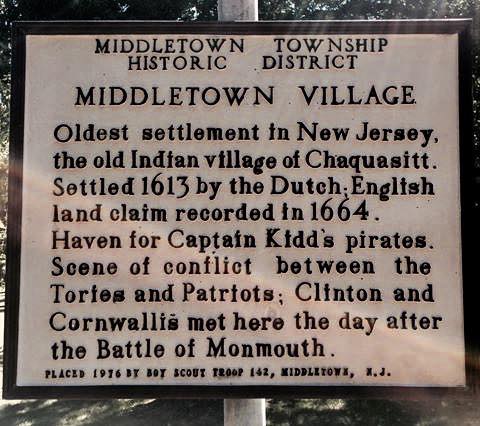
In his book South Jersey Towns (Rutgers University Press, 1973), William McMahon relocates Captain Kidd’s coveted treasure a bit farther south in New Jersey. He writes:
In the late summer of 1698, according to Brigantine legend, the Barkentine which served as the flagship for the notorious Captain William Kidd…anchored near the mouth of Brigantine Inlet. Captain Kidd, his mate Timothy Jones, and several of the crew came ashore in a long boat, on the bottom of which rested a heavy leather and brass-bound sea chest which they buried among the dunes of the island. Later, according to the story, Kidd and Jones returned, dug up the chest, and re-interred it elsewhere. A fight ensued, and Jones was killed by Kidd, who buried his former mate beside the chest before departing. The alleged loot has never been found.
Will the ill-gotten fortune of the pirate captain William Kidd ever be found? No one knows. But the next time you’re strolling the shoreline along a New Jersey beach you might just want to keep your eyes open for a shiny souvenir in the rolling surf––because sometimes what glitters may actually be gold.










